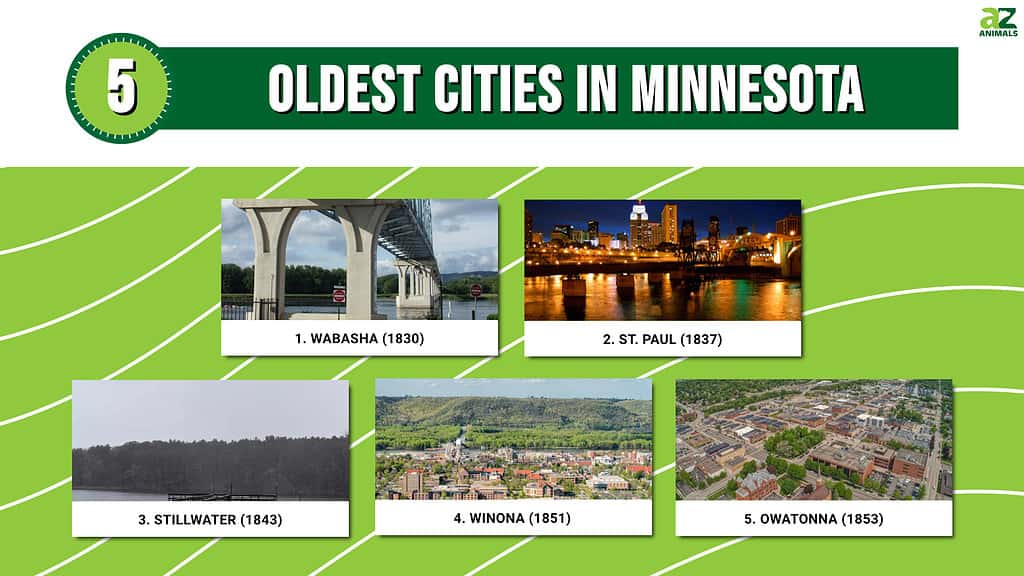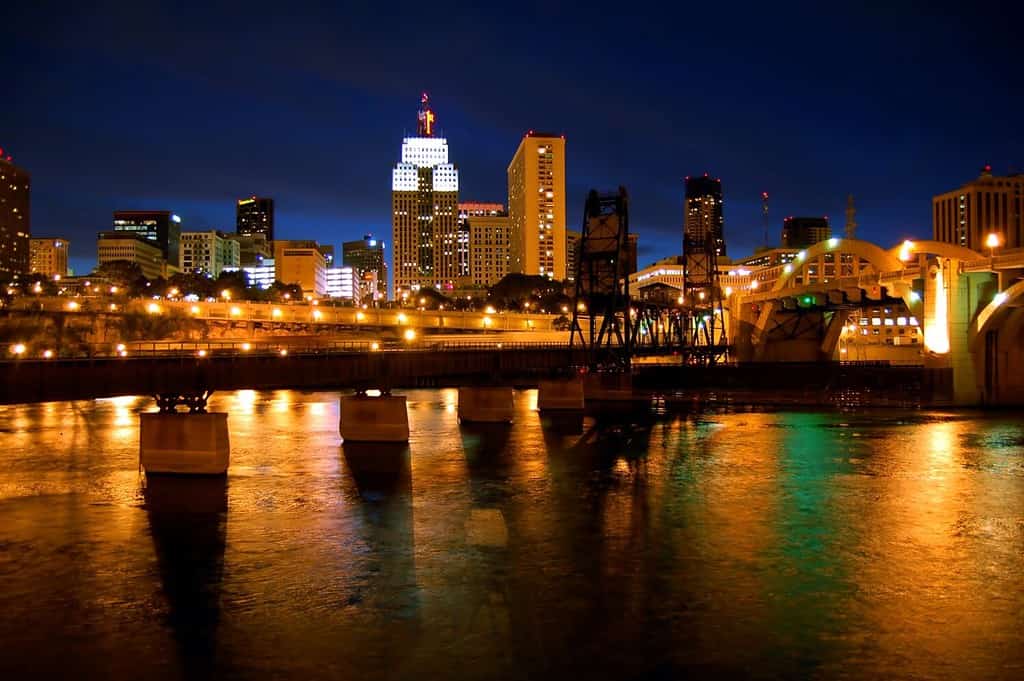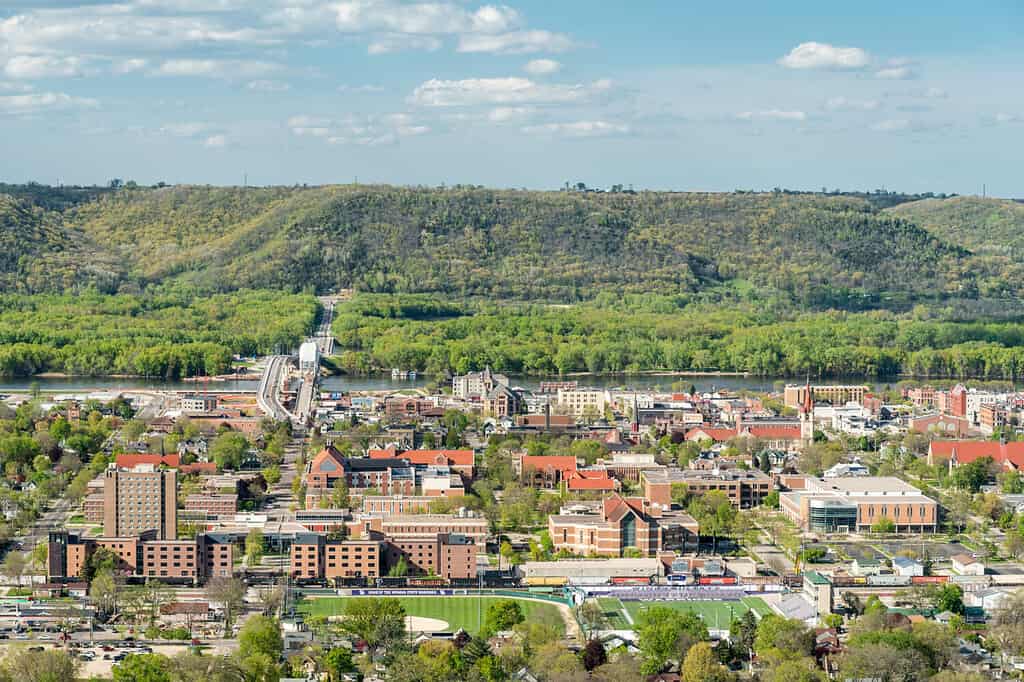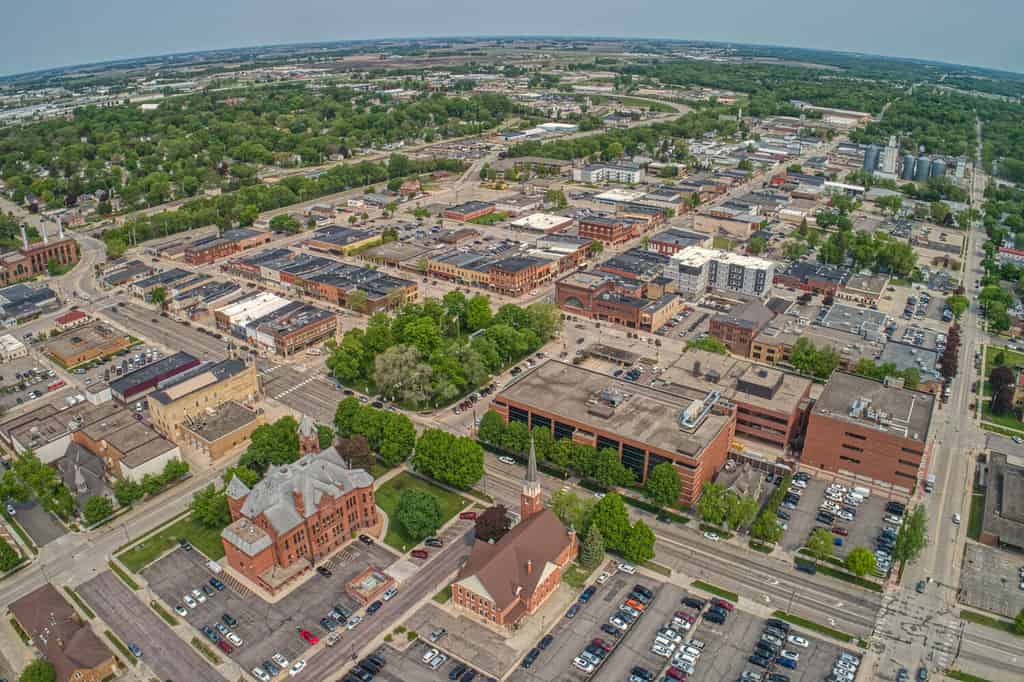Ever been to Minnesota? If not, we’re about to convince you it’s worth the trip! If you’re craving forests, lakes, or the great outdoors, you won’t be disappointed. But Minnesota has a lot more than just gorgeous natural scenery. Join us in exploring five of the oldest cities in Minnesota.
(What qualifies as a city? There’s not one standard definition. For the sake of simplicity, we are focusing on cities that have a population of at least 1,500. We’re not covering ghost towns but highlighting places you can visit and find interesting things to see and do.)
So, pack your bags and let’s go!

1. Wabasha, 1830 (population 2,559)
Washaba’s history goes way back to the 1600s when indigenous people and fur traders lived in the area. It wasn’t founded formally as a town until 1830, though. The name of the town is unique because it was formed from the name of three Native American chiefs, a father, son, and grandson, who signed treaties with the U.S. government. Washaba is a Mississippi riverfront city and still has working steamboats that offer excursions.
There’s a lot to see in the city. The historic district downtown has over 50 buildings listed in the National Register of Historic Places. One you might particularly want to notice is the Grace Memorial Episcopal Church which has a Tiffany stained glass window. Wabasha is also home to the National Eagle Center because the area has hundreds of bald eagles nesting there in the winter – the largest concentration of eagles in the lower 48 states. If you happen to be there in February, don’t miss the Grumpy Old Men Festival. You can visit places mentioned in the movie Grumpy Old Men, see a parade, take part in a fishing tournament, eat good food, and participate in winter sports.

The Wabasha–Nelson Bridge is a truss bridge that connects Wabasha, Minnesota with Nelson, Wisconsin.
©Bryan Murray/Shutterstock.com
2. St. Paul, 1837 (population 311,527)
St. Paul is the state capital. It’s in a highly strategic location where the Mississippi and Minnesota rivers meet. The Native American Hopewell civilization lived there about 2,000 years ago and left behind burial mounds you can still see today. In the early years of Euro-American settlement, St. Paul was a fur-trading center and the site of an army fort. It was called “Pigs Eye.” Later the settlement was renamed for a Catholic chapel named St. Paul. The city grew as a convenient landing site for riverboats and became known as “The Last City of the East.” One of the city’s lesser-known claims to fame is that it was the birthplace of Charles M. Schultz, the cartoonist of Peanuts fame.
There are endless activities to do in St. Paul. Here are just a few:
- Indian Mounds Regional Park: have a look at six ancient Native American burial mounds and learn about the culture that created them.
- Fort Snelling: a frontier fort built in 1819 that was significant in conflicts with Native Americans, a barracks for Union soldiers in the Civil War, and a training center for World War II spies.
- Cathedral of St. Paul: a large domed church visible for miles and modeled after St. Peter’s in Rome.
- The Minnesota State Fair: a 12-day event drawing two million visitors. You’ll see prize-winning livestock, art, talent, and agricultural produce presented by over 1,000 vendors and exhibits.

St. Paul is the state capital. It’s in a highly strategic location where the Mississippi and Minnesota rivers meet.
©Near and Far Photography/Shutterstock.com
3. Stillwater, 1843 (population 19,394)
Stillwater started when four settlers started the Stillwater Lumber Company. One of them had migrated from the town of Stillwater, Maine, and the name seemed appropriate for the new settlement because of the nearby calm and still St. Croix River. To show you the importance of Stillwater, it’s known as the “birthplace of Minnesota” because a convention was held there in 1848 that chose St. Paul as the capital and established the University of Minneapolis. Stillwater got the short end of this deal as it was chosen as the site of the territory’s first prison, which is today Minnesota State Prison. Some of the most notorious inmates were Cole, Jim, and Bob Younger who were part of the James-Younger gang with Jesse and Frank James.
What can you do in Stillwater today? Visit the Stillwater Lift Bridge Historic Site, an iconic monument in the city. Check out Brown’s Creek Trail, an 18-mile route open year-round for skiing, running, walking, horseback riding, biking, or rollerblading. You can charter a yacht or gondola ride, a trolley tour, or visit local vineyards. And don’t leave without visiting historic Nelson’s Ice Cream which reportedly doles out the largest ice cream scoops in a 5-state area. Which of course makes us wonder, just how big are they in the 6th state?

Square Lake Park in Stillwater, Minnesota is a popular place for outdoor recreation.
©Krueger’s Media Design/Shutterstock.com
4. Winona, 1851 (population 25,948)
Winona sits on the west bank of the Mississippi River in southeastern Minnesota. In the indigenous Dakota language of the area, the name “Wee-no-nah” was the name for a first-born daughter. Colonists from New England first settled the area and by 1856, 3,000 people were living there. The city was able to prosper around the industries of lumber, steam boating, railroads, and wheat. Railroad bridges over the Mississippi further helped the area to prosper.
The most noticeable landmark in Winona is Sugar Loaf, a rock structure that looks like a yellowish-colored castle on a hill. It’s what remains after quarrying for stone to use for building and road construction. Winona Lake Park has a five-mile trail popular for biking, hiking, and in-line skating. Veteran’s Memorial Park there has a beach, boat dock, playgrounds, winter skating rink, picnic areas, sports fields, a band shell, and a rose garden. Visitors can kayak, canoe, stand-up paddleboard, and fish on the lake. Other attractions in the city are the Minnesota Marine Art Museum, the Polish Cultural Institute and Museum, and the Watkins Museum and Store.

The city was able to prosper around the industries of lumber, steam boating, railroads, and wheat.
©Randy Runtsch/Shutterstock.com
5. Owatonna, 1853 (population 26,420)
Owatonna is located about 60 miles south of Minneapolis. According to legend, the city was named after Princess Owatonna, the daughter of Chief Wadena who was healed by the waters of a nearby spring. In 1886 the city became the home of the Minnesota State Public School for Dependent and Neglected Children – a school and an orphanage that over the years housed over 10,000 children before it closed in the 1940s. During World War II, 200 German prisoners of war were housed in a camp in the city and were paid to work in local nurseries, farms, and canning companies.
Owatonna has good shopping at Cabela’s World’s Foremost Outfitter, a Russell Stover Candies store, and the Ultra Outlets of Medford. The Reptile and Amphibia Discovery Zoo has a fine collection of species, some of them quite rare. Kids can feed and pet some of the animals. There are a lot of good parks in the area: Kaplan’s Woods State Park, Kaplan’s Woods Parkway and Lake Kohlmier, Mineral Springs Park, and Rice Lake State Park. These are great places for hiking, watersports, cross-country skiing, and camping.

Owatonna has good shopping at Cabela’s World’s Foremost Outfitter, a Russell Stover Candies store, and the Ultra Outlets of Medford.
©Jacob Boomsma/Shutterstock.com
The Oldest Cities in Minnesota Don’t Disappoint
Minnesota is a state full of history, but also plenty of interesting things to do today. Hiking, boating, camping, riverboat rides, museums, shopping, and country fairs – these are just a few of the relaxing and memory-making experiences you can have. Now it’s just up to you to include some of the oldest cities in Minnesota on your next vacation.
Summary of 5 of the Oldest Cities in Minnesota
| Rank | City | Year of Establishment |
|---|---|---|
| 1 | Wabasha | 1830 |
| 2 | Stillwater | 1843 |
| 3 | St. Paul | 1837 |
| 4 | Winona | 1851 |
| 5 | Owatonna | 1853 |
The photo featured at the top of this post is © iStock.com/Susan Rydberg
Thank you for reading! Have some feedback for us? Contact the AZ Animals editorial team.






